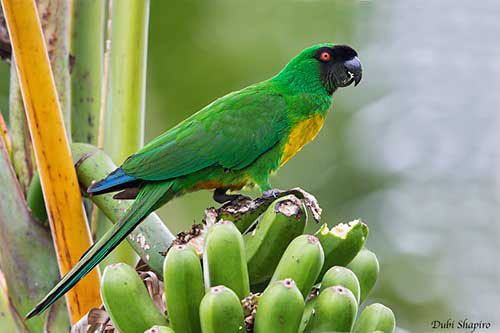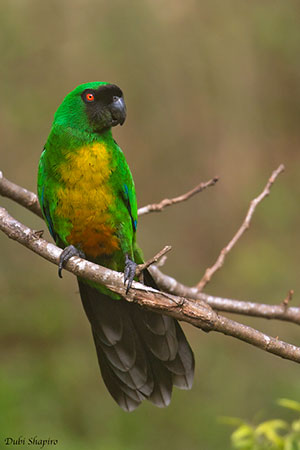
The Masked Shining Parrot is often heard before to be seen. It is noisy and conspicuous while flying.
Like other parrots, this species nests in cavities.
It is sedentary.
The flight is gently undulating, with wingbeats interspersed with glides. It is able to twist and turn quickly through the forest.
REPRODUCTION OF THIS SPECIES:
The breeding season takes place between July and September.
The Masked Shining Parrot nests in cavity, a hole in large tree in forest, or a hole in the top of a stump. The cavity is enlarged with the powerful bill.
The female lays two white eggs, but probably more from some local observations.
PROTECTION / THREATS / STATUS:
The Masked Shining Parrot is threatened by habitat loss due to deforestation involving forest fragmentation and loss of nesting trees. Less than 50% of forests still remain on Viti Levu.
The global population is estimated to number 65,605/108,270 individuals, rounded to 88,000 birds. This population is suspected to decline due to habitat loss.
The Masked Shining Parrot is currently classified as Near Threatened.
Fr : Perruche masquée
Ang : Masked Shining-Parrot
All : Maskensittich
Esp : Papagayo Enmascarado
Ita : Pappagallo splendente mascherato
Nd : Maskerparkiet
Sd : svartkindad glansparakit
Photographer:
Dubi Shapiro
Dubi Shapiro Photo Galleries & Dubi Shapiro's Pictures on IBC
Text by Nicole Bouglouan
Sources :
HANDBOOK OF THE BIRDS OF THE WORLD vol 4 by Josep del Hoyo-Andrew Elliott-Jordi Sargatal - Lynx Edicions - ISBN: 8487334229
PARROTS OF THE WORLD – An Identification Guide – by Joseph M. Forshaw – Princeton University Press – ISBN 0691092516
Parrots: A Guide to Parrots of the World Par Mike Parr, Tony Juniper – Editeur: A& C Black, 2010 – ISBN: 1408135752, 9781408135754 - 584 pages
THE AVIANWEB - Beauty of Birds (Sibylle Faye)
Masked Shining Parrot
Prosopeia personata
Psittaciformes Order – Psittaculidae Family
INTRODUCTION:
The parrots of this genus are named « shining parrots » because of sheen on back and wings. They have long, graduated, rounded tail and they are large, slim parrots. The present species is the largest of this genus. It is found on Viti Levu in Fiji archipelago. It is also named “Masked Parrot” due to the blackish facial mask.
The Masked Shining Parrot frequents mature forests and also visits gardens near or in villages.
This species is threatened by deforestation and forest fragmentation. It is currently classified as Near Threatened.
DESCRIPTION OF THE BIRD:
Biometrics:
Length: 47 cm
Weight: 322 g
The Masked Shining Parrot adult has mainly bright, pale green plumage on upperparts, wings and tail, and outer parts of the underparts where there is a broad yellow-orange stripe on centre of belly. On the upperwings, the outer webs of primaries are violet-blue. The uppertail is slightly washed blue.
On the underwings, the wing-coverts are green, but the flight-feathers are darker green. Vent and undertail-coverts are green, whereas rectrices are darker greenish-brown. Throat, upperbreast, body sides and flanks are green. Centre of breast and belly are mostly yellow with some feathers tipped green. There is an orange patch on lower belly.
On the green head, crown and nape are brighter with glossy feathers. The face including forecrown, lores, cheeks and chin is black.
The bill is blackish. The eyes are red-orange. Legs and feet are dark grey.

Male and female have similar plumage, but the male has heavier head and bill.
The juvenile resembles adults but the black mask is reduced, the bill is horn-coloured with grey streaks and the eyes are brown.
RANGE:
The Masked Shining Parrot is found on Viti Levu in Fiji archipelago.
HABITAT:
The Masked Shining Parrot frequents mature forests and thick, tall secondary growths. It can be seen in cultivated areas, in gardens near or in villages, and it often ventures into mangroves. It also perches in trees along watercourses. This species occurs from sea-level up to 1,200 metres of elevation.
CALLS AND SONGS: SOUNDS BY XENO-CANTO
The Masked Shining Parrot produces grating notes in flight, some harsh “raaa” or “kreee” usually repeated. The alarm call is a rapidly repeated, high-pitched similar note.
The perched bird utters cackling sounds and may produce a dry bill-rattle.
BEHAVIOUR IN THE WILD:
The Masked Shining Parrot feeds on berries, cultivated fruits and ripening crops.
It is usually seen alone or in pairs, but outside breeding season, flocks of 20-40 birds are seen flying together above treetops or through the forest.
They often perch in trees, but they come to lower level to feed on fruits such as mango, guava, figs and bananas.
However, they also consume flowers, insects, seeds and cultivated grain.
Like most Psittaciformes, the Masked Shining Parrot typically holds the food item with the foot, but it uses its bill to grip branches while moving in trees.
This species emits a musky scent giving it another name “Musk Parrot”. This strong odour can be detected at close range.
